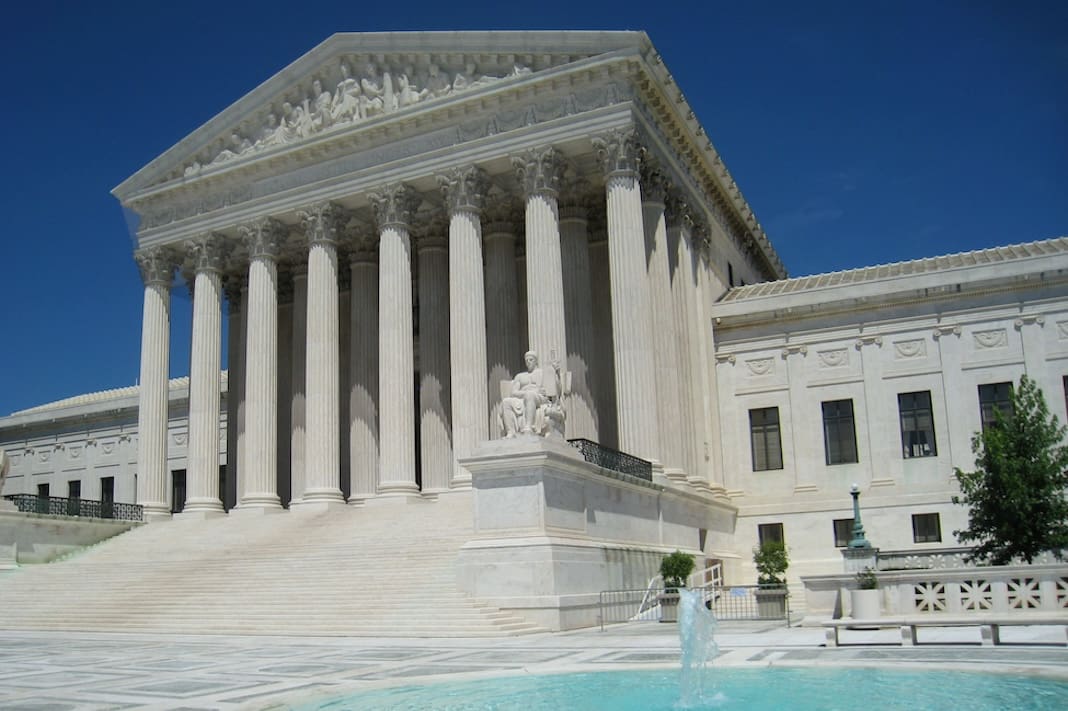Common Cause’s Jay Heck: ‘The ramifications are huge’ in Wisconsin Supreme Court election

Nick Vachon
The director of Common Cause Wisconsin, a government reform advocacy organization, says that the April Supreme Court election carries massive implications for democracy in the state and nationally.
Jay Heck is the executive director of Common Cause Wisconsin, the state branch of one of the nation’s largest government reform advocacy groups. Heck has worked in Wisconsin politics for decades and has had something of a front-row seat to the growth of the polarization that now characterizes state politics, as well as the steady erosion of campaign finance laws that has allowed the race for the open seat on the Supreme Court of Wisconsin to become the most expensive judicial election in the country’s history.
The primary last month winnowed down the field to two candidates, liberal Milwaukee County Judge Janet Protasiewicz and conservative former Supreme Court Justice Daniel Kelly. With the retirement of Justice Patience Roggensack, who votes with the court’s conservative majority, liberals have a chance to take control of a court they haven’t held since 2008.
If Protasiewicz wins, Heck told the American Independent Foundation, the newly minted liberal majority will have the opportunity to rule on abortion rights, the state’s deeply gerrymandered legislative maps, and the rules for conducting the 2024 presidential election.
In a wide-ranging interview, Heck dove into the history of Wisconsin’s once solidly nonpartisan Supreme Court elections and clarified the stakes of this high-profile off-year election. The following has been edited and condensed.
Nick Vachon, the American Independent Foundation: You’re the executive director of Common Cause Wisconsin. Tell me what you and your group do.
Jay Heck: Common Cause Wisconsin is the state affiliate of national Common Cause, and that is a national organization headquartered in Washington, D.C. It was founded in 1970 by John Gardner as a citizen’s reform lobby organization to stop the Vietnam War and then quickly evolved into a political reform organization because, shortly after Vietnam ended, Watergate began. The purpose is really to monitor the behavior of elected officials at the federal and state level and then pass reforms that make government and politics more transparent and more accountable to voters, to citizens. We have a presence in 35 states, nonpartisan, we don’t endorse candidates, but we have very specific views on issues, as you might imagine. So, in the Wisconsin Supreme Court election, for instance, it’s coming up on April 4, we don’t tell people who we think they should vote for. But we certainly inform people about where the two candidates are on issues that we care about.
TAIF: Turning to some of those Wisconsin-specific issues, I want to ask you about the state’s legislative maps, which the Princeton Gerrymandering Project gave an F. Just how bad are these maps?
JH: Well, the redistricting process and the gerrymandering in Wisconsin began, as it did all over the country, 10 years ago, in 2011. At that point, it was the first time in 60 years that one party had unified control of all of the levers of power, the governorship and both houses of the Legislature, which enabled them to, if they wanted to, craft very gerrymandered maps. In 2010, as a result of ungerrymandered maps, the Republicans won control. What the Republicans did in 2011 was, they went to the greatest extreme and they crafted what have been characterized as the most partisan gerrymandered maps of any in the country in 2011.
Redistricting must be done, according to the Constitution, after the census. It has to be done after the census, but it can be revisited again, by a legislature or by a court, if they choose to do so. And that is one of the reasons why — and there are many other issues — but it is an absolute truism that the voting maps and the redistricting process will have huge implications depending on the outcome on April 4.
TAIF: I want to get to the race in a bit more depth in a moment. But I want to pause for a moment and ask if this kind of partisan rule-bending is in line with the state’s history.
JH: No, in fact, it is diametrically opposite to the experience, particularly in Wisconsin, that we have had prior to 2008 or 2009. Wisconsin’s Supreme Court for years was considered to be one of the most impartial and nonideological of any high court in the country. It was often difficult to tell who the real conservatives and the progressives were on the court because often when a candidate ran for the Supreme Court they would seek the endorsement of both a past Republican and a past Democratic governor. And the thing that was wonderful about that is that it gave some real meaning to the idea of an impartial judiciary.
But that all changed in a very dramatic way in the late 2000s when special interest groups, particularly on the right, began to weigh in very heavily with big expenditures, outside spending. And they turned what had been $500,000 races for statewide office, for the Supreme Court into free-spending, obscene amounts of outside money being spent on these elections. This is important to note: In 2015, Gov. Scott Walker and the Republican Legislature totally rewrote the campaign finance laws and basically allowed for unlimited spending in races like the Supreme Court, as well as they erased disclosure, by and large, and most significantly, they legalized something that is still illegal in almost every other state in the country and at the federal level, and that is coordination between outside groups, like Wisconsin Club for Growth, Wisconsin Right to Life — there’s groups on the left too — with candidates.
Nowhere in the country are you or outside groups allowed to coordinate their activities with candidates. In Wisconsin you’re allowed to do that. So what we have now in Wisconsin are Supreme Court candidates who are not only obviously of the left or the right, but Democratic and Republican Party operatives and outside spending groups are now coming into Wisconsin and coordinating directly with the candidates, both Janet Protasiewicz and Daniel Kelly, and that is unprecedented, and it’s in my view horrific.
TAIF: Speaking of Kelly, he used to be a justice, and I’m curious if you can tell me anything about how he ruled during his tenure on issues surrounding good government and redistricting, which are obviously two of the major focuses of your group.
JH: Kelly was appointed to the court to fill out the term of another conservative, David Prosser, who resigned after being reelected in 2011. He was very conservative on the court. After his defeat in the spring of 2020, he then became a prominent spokesperson for Trump, and after Trump lost Wisconsin by 20,500 votes in November of 2020, Kelly was very much one of the election deniers who charged voter fraud, and of course there was no voter fraud. So Kelly was very much of that school; he was hired by the Republican Party of Wisconsin, he was a paid employee of the Republicans, he has lined up consistently for election denialism and has also been one of those conservatives who have worked actively to try to make voting more difficult in Wisconsin. There’s no doubt that if he were elected to the court, he would join the conservative majority.
Certainly, on redistricting, he has enunciated his belief that it’s the Legislature that has maximum deference to be able to create the kind of voting maps that they want to, so the repercussions are huge in that respect as well.
TAIF: Let’s turn to his opponent, Judge Janet Protasiewicz, who, as you said, is the liberal candidate. She’s been on the record saying that the maps are, to use a direct quote, “rigged,” and if she wins, most observers that I’ve spoken to seem convinced that she’d vote with other liberals to replace the maps. Do you think that’s true? And if it is, what are the steps that progressives would have to go through to bring a challenge in front of the court?
JH: Protasiewicz has said a number of times that she believes that the voting maps that were adopted by the conservatives on the court were rigged, and that she would be open to a challenge to those maps. It would simply have to be brought by an injured party, and that could be a voter in almost any area in Wisconsin that’s in a gerrymandered district, who would make the argument that their vote doesn’t have the same weight as somebody voting for a Republican because of the inability for there ever to be a Democratic majority in either chamber in the Legislature even if there are more votes for those candidates.
The expectation from what we’ve heard being said by Protasiewicz and what the progressive judges wrote when the conservatives rammed through the maps for the Republican-controlled Legislature is there would be a 4-3 decision to throw out the maps that the Republicans in the Legislature had adopted, and that the court would entertain then a different set of maps.
TAIF: Finally, we’ve talked a lot about redistricting and voting rights, but I was wondering if there are any other implications that you think this race has for good government and the health of democracy broadly in Wisconsin that maybe aren’t getting enough airtime.
JH: Well, I think one of the things that people should consider not just in Wisconsin but nationally is that, because of the way the United States Supreme Court has shifted to both legislatures and to state courts increasing power to make decisions about voting, elections, and redistricting, there are huge implications for the 2024 presidential election. Wisconsin is one of those three or four states that will be decided on a very narrow margin. So whoever controls the Wisconsin Supreme Court will have an awful lot to say about the decisions that are made if the election is close.
But for the people in Wisconsin the ramifications are huge too, because we’ve now gone from a time of 25 years ago when people had relative confidence in their court as being impartial, and a court that was going to rule according to law, to a place where we’re now, it’s very ideological and it’s polarized. And I might tell you I am disturbed by the fact that progressive candidates for the judiciary are now openly talking about their position on redistricting and on abortion. That’s not what people, I think, used to expect from courts. They used to expect, regardless of what the judge’s personal view might be, that they were going to take the facts of the case and decide it that way. I don’t think people have that confidence anymore. I think they assume that you pretty much know the outcome of every vote on almost any issue that comes before the court, and I think that’s something of a tragedy.
Published with permission of The American Independent Foundation.




